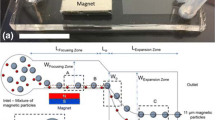Abstract
Chemical cytometry studies the molecular composition of individual cells by means of capillary electrophoresis or capillary chromatography. In one of its realizations an intact cell is injected inside the capillary, the plasma membrane is disrupted to release the cellular contents into the separation buffer, and, finally, the molecules of interest are separated and detected. The solubilization of the plasma membrane with a surfactant is a simple and efficient way of achieving cell lysis inside the capillary. To facilitate cell lysis by a surfactant the cell has to be contacted with the surfactant inside the capillary. We recently introduced a generic method for mixing solutions inside the capillary termed transverse diffusion of laminar flow profiles (TDLFP). In this work, we propose that TDLFP can facilitate efficient cell lysis inside the capillary. Conceptually, a short plug of the surfactant is injected by pressure prior to cell injection. The cell is then injected by pressure wizthin a plug of the physiological buffer. Due to the parabolic profiles of pressure-driven laminar flows the interface between the plug of the surfactant and that of the physiological buffer is predominantly longitudinal. Transverse diffusion mixes the surfactant with the physiological buffer, which leads to surfactant’s contact with the cell and subsequent cell lysis. Here, we demonstrate that the proposed concept is valid. TDLFP-facilitated cell lysis by a short plug of the surfactant allows us to exclude the surfactant from the run buffer, and, hence, facilitates modes of separation, which are incompatible with the surfactant’s presence in the run buffer. In addition to cell lysis, TDLFP will be used to mix the cellular components with labeling reactants, affinity probes, inhibitors, etc. We foresee that the generic nature and enabling capabilities of TDLFP will speed up the maturation of chemical cytometry into a practical bioanalytical tool.



Similar content being viewed by others

References
Krylov SN et al (1999) Correlating cell cycle with metabolism in single cells: combination of image and metabolic cytometry. Cytometry 37:14–20
Zhang Z et al (2000) One-dimensional protein analysis of an HT29 human colon adenocarcinoma cell. Anal Chem72:318–322
Krylov SN et al (2000) Instrumentation for chemical cytometry. Anal Chem 72(4):872–878
Edstrom JE (1953) Nucleotide analysis on the cyto-scale. Nature 172:908
Dovichi NJ, Hu S (2003) Chemical cytometry. Curr Opin Chem Biol 7(5):603–608
McClain MA et al (2003) Microfluidic devices for the high-throughput chemical analysis of cells. Anal Chem 75(21):5646–5655
Wu H, Wheeler A, Zare RN (2004) Chemical cytometry on a picoliter-scale integrated microfluidic chip. Proc Natl Acad Sci USA 101(35):12809–12813
Hu K, Ahmadzadeh H, Krylov SN (2004) Asymmetry between sister cells in a cancer cell line revealed by chemical cytometry. Anal Chem 76(13):3864–3866
Sims CE et al (1998) Laser-micropipet combination for single-cell analysis. Anal Chem 70(21):4570–4577
Arkhipov SN et al (2005) Chemical cytometry for monitoring metabolism of a ras-mimicking substrate in single cells. Cytometry 63A(1):41–47
Healy KE, Lom B, Hockberger PE (1994) Spatial distribution of mammalian cells dictated by material surface chemistry. Biotech Bioeng 43:792–800
Krylov SN, Dovichi NJ (2000) Single-cell analysis using capillary electrophoresis: Influence of surface support properties on cell injection into the capillary. Electrophoresis 21:767–773
Tlsty TD (1998) Cell-adhesion-dependent influences on genomic instability and carcinogenesis. Curr Opin Cell Biol 10(5):647–653
Xue Q, Yeung ES (1996) Determination of lactate dehydrogenase isoenzymes in single lymphocytes from normal and leukemia cell lines. J Chromatogr B Biomed Appl 677(2):233–240
Han F et al (2003) Fast electrical lysis of cells for capillary electrophoresis. Anal Chem 75 (15):3688–3696
Xue Q, Yeung ES (1994) Variability of intracellular lactate dehydrogenase isoenzymes in single human erythrocytes. Anal Chem 66(7):1175–1178
Kristensen HK, Lau YY, Ewing AG (1994) Capillary electrophoresis of single cells: observation of two compartments of neurotransmitter vesicles. J Neurosci Methods 51:183–188
Okhonin V, Liu X, Krylov SN (2005) Transverse diffusion of laminar flow profiles to produce capillary nanoreactors. Anal Chem 77 5925–5929
Taylor JA, Yeung ES (1993) Imaging of hydrodynamic and electrokinetic flow profiles in capillaries. Anal Chem 65:2928–2932
Acknowledgment
The authors thank Victor Okhonin, Zhenchuan Miao, and Zhulin Pang for technical assistance. This work was supported by the Natural Sciences and Engineering Research Council of Canada: Discovery and Strategic Projects grants for SNK and an NSERC Postdoctoral Fellowship for MVB.
Author information
Authors and Affiliations
Corresponding author
Rights and permissions
About this article
Cite this article
Berezovski, M.V., Mak, T.W. & Krylov, S.N. Cell lysis inside the capillary facilitated by transverse diffusion of laminar flow profiles (TDLFP). Anal Bioanal Chem 387, 91–96 (2007). https://doi.org/10.1007/s00216-006-0866-7
Received:
Revised:
Accepted:
Published:
Issue Date:
DOI: https://doi.org/10.1007/s00216-006-0866-7



